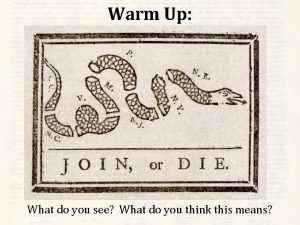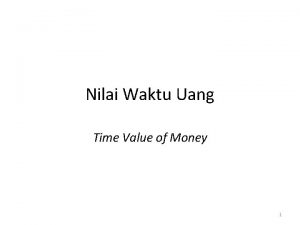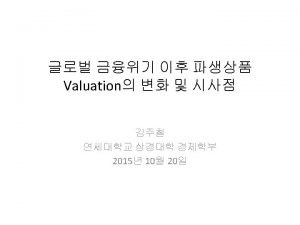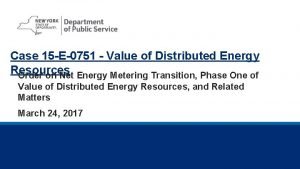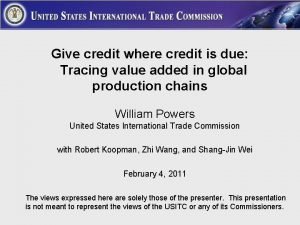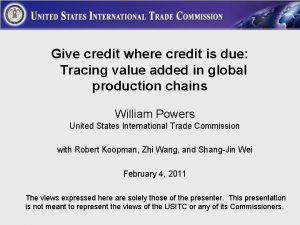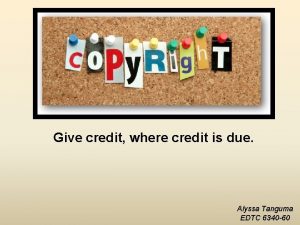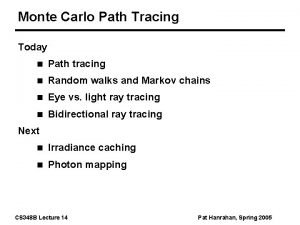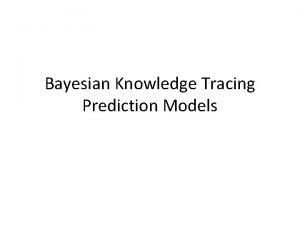Give credit where credit is due Tracing value













- Slides: 13

Give credit where credit is due: Tracing value added in global production chains William Powers United States International Trade Commission with Robert Koopman, Zhi Wang, and Shang-Jin Wei November 18, 2011 The views expressed here are solely those of the presenter. This presentation is not meant to represent the views of the USITC or any of its Commissioners.

Presentation outline • Global value chain analysis: Two IO-based approaches • Conceptual framework for ICIO-based analysis from Koopman et al. (2010) • Applications – Country and regional integration into global value chains – Direct and indirect exports of services – Bilateral trade deficits • Conclusions and “wish list” for APEC 1

Value chain analysis based on IO-tables: 2 alternatives • Single country models – Often based on Hummels, Ishii, Yi, 2001 – Advantages: up-to-date; easy to measure foreign input in domestic production and exports – Disadvantage: cannot determine sources of imported value • Inter-Country Input-Output (ICIO) models – Major databases: IDE-JETRO, WTO, OECD, World Input-Output Database, GTAP-based (e. g. , Koopman et al. 2010; USITC 2011) – Advantages: Can track ultimate source and destination of value in global production networks – Disadvantages: Complex, latest databases only through 2007 2

Value-chain analysis with single-country (U. S. ) IO table Source: USITC, 2011, Import Restraints. • No estimates of foreign content in U. S. exports existed for recent years • USITC put together an estimate for 1998– 2009 relatively quickly 3

Value chain analysis with ICIO: Gross output • For simplicity, start with a 2 -country framework • All output is used as an intermediate or final good at home or abroad Xr: (gross output of country r); Yr: (output of r’s final goods) Ars: (ICIO Coefficient matrix: use in country s of intermediates from r) • Put in block matrix notation and rearrange Bsr: (Block Leontief inverse matrix: the amount of total output in s required for a one-unit increase in final demand in country r 4

ICIO framework: Value added in exports • Value-added in exports of each sector in all countries: Vr: domestic value-added coefficient vector: gives r’s direct domestic value added in production of each sector Er: official gross exports includes exports of both intermediate and final goods • • Not standard application of Leontief inverses to final demand, but Completely decomposes official trade flows into VA components Generalizes existing measures, such as HIY’s vertical specialization Fully generalizable to many country world – Tracks indirect flows through third countries (e. g. , Japan China US) – Tracks indirect flows through other sectors 5

Completely decomposes gross exports Gross exports Domestic value added Exported in final goods Exported in intermediates absorbed by direct importer Foreign value added Exported in intermediates reexported to third countries Exported in intermediates that return home 6

Completely decomposes gross exports Advanced economies Asian NICs Emerging Asia NICs Other emerging China Mexico Other emerging Source: Koopman et al. (2010) 7

Indirect exports of value-added: business services Business services (e. g. , accounting, legal, IT) Direct Exports Business services Motor vehicles Machinery Indirect Exports Electronics Etc. • IO tables track value created in one industry but exported by another • Indirect exports are more important for some countries than others • Value-added measures can change our impression of comparative advantage 8

Value added can change our impression comparative advantage of • Revealed comparative advantage (RCA) is often used as a measure of export competitiveness • Measured with gross exports, India has a strong RCA because of its high share of business services exports in its total exports • Measured with value added, advanced economies have strong RCA in the sector, because of their high value of indirect business services exports Source: Koopman et al. (2010) 9

Value added can change our impression bilateral trade deficits U. S. Bilateral Trade Deficits , 2004 (billion $) Gross trade deficit Source: USITC, 2011, Import Restraints of Examples: • China and Mexico use inputs from many countries to produce exports, so VA exports are smaller than official gross exports hence the U. S. bilateral trade deficits shrink in VA terms • Japan sends substantial value through third countries (as do Russia, Australia, and NICs), so U. S. bilateral trade deficits are higher in VA terms • The overall U. S. trade deficit is the same in value-added or gross terms 10

Conclusions • Single-country IO frameworks can play a role • But ICIO can provide substantial insight, especially when measures are consistent with official trade flows – – Bilateral trade balances Export strength and revealed comparative advantage Reliance of exports on imports Reliance on foreign demand foreign supply • “Wish list” for APEC – Disaggregation of all APEC countries and their major trading partners in ICIO databases – Extension of survey-based ICIO coefficients to additional countries – Better understanding of changes in sources and destinations of 11 inputs over time

Questions/Comments? • Contact information – – Bill Powers Research Division, Office of Economics U. S. International Trade Commission william. powers@usitc. gov • Sources – Koopman et al. , 2010, “Give Credit Where Credit is Due, ” http: //www. nber. org/papers/w 16426 – USITC, 2011, “The Economic effects of significant U. S. import restraints, ” http: //www. usitc. gov/publications/332/pub 4253. pdf 12
 This can be avoided by giving credit where credit is due.
This can be avoided by giving credit where credit is due. Contoh value creation
Contoh value creation What is the main idea of give me liberty or give me death
What is the main idea of give me liberty or give me death Figura con 4 lati
Figura con 4 lati Procedural due process vs substantive due process
Procedural due process vs substantive due process Grande rhetra
Grande rhetra Principio di conservazione della quantità di moto
Principio di conservazione della quantità di moto What is the present value of a $600 perpetuity
What is the present value of a $600 perpetuity Future value of annuity formula
Future value of annuity formula Tabel present value interest factor
Tabel present value interest factor Credit valuation adjustment example
Credit valuation adjustment example Cdg value stack credit
Cdg value stack credit Wavefront distributed tracing
Wavefront distributed tracing Coast guard manufacturers identification code
Coast guard manufacturers identification code


